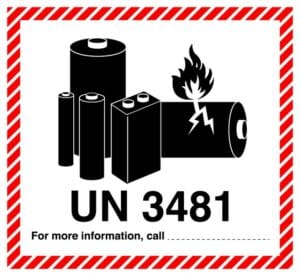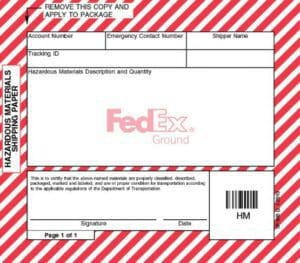 The global COVID-19 pandemic has significantly boosted e-commerce sales as people adapted to stay-at-home and shelter-in-place orders. As sales skyrocketed, returns inevitably followed suit. But without brick and mortar locations readily available to handle returns in store, shipping returns – accompanied by all of their complexities – rose in prominence and volume. One of those complexities stands out above the rest as particularly troublesome: HAZMAT returns.
The global COVID-19 pandemic has significantly boosted e-commerce sales as people adapted to stay-at-home and shelter-in-place orders. As sales skyrocketed, returns inevitably followed suit. But without brick and mortar locations readily available to handle returns in store, shipping returns – accompanied by all of their complexities – rose in prominence and volume. One of those complexities stands out above the rest as particularly troublesome: HAZMAT returns.
What most people think of when they hear HAZMAT are contagions or nuclear materials, and while those certainly qualify, the most common HAZMAT shipments contain phones, laptops, e-cigarettes and other items containing lithium ion batteries, pressurized canisters or cosmetics that contain certain ingredients. While these are generally safe for individuals to have and use, in high volumes, they can become quite dangerous under certain conditions. For example, a truck containing a full load of broken cell phones gets into an accident and catches fire.
Most companies are familiar with the federal, state and local rules and regulations established by departments of transportation for outbound HAZMAT shipments. HAZMAT returns, on the other hand, introduce a new and much less reliable player into the game: the consumer. When a consumer needs to return items that qualify as HAZMAT, they must follow the same established rules and regulations – and those rules and regulations must be provided by the retailer accepting the return shipment.
Let’s examine a common scenario: A mobile phone company launches a new phone to much fanfare; normally there are lines of people outside the store who not only purchase the new phone, but also trade in their current phone for credit or recycling. During the era of COVID-19, those stores may be closed, meaning all those individuals who purchased new phones and traded in existing models must do so online. If a family of five capitalize on a great deal to upgrade, the five old phones must be returned. But because of HAZMAT rules and regulations, they can’t include all five phones they plan to return in the same box. The mobile phone company must provide them instructions as well as materials including the appropriate number and variety of shipping labels for the return shipments. The family must then package the phones according to these directions, including placing the dangerous materials placard on the box. Then they must take these to the designated shipping carrier and validate what’s in the box to label everything appropriately. The carrier serves as the quality assurance center, making sure everything was done correctly, and if not, the family must try and correct the issues and do the process all over again. That’s a heavy burden to put on the consumer.
 So how can companies ease that burden while still ensuring compliance with HAZMAT returns, especially as e-commerce booms and peak shopping season approaches?
So how can companies ease that burden while still ensuring compliance with HAZMAT returns, especially as e-commerce booms and peak shopping season approaches?
The first step is to examine current returns processes. Some companies facilitate instant returns by including all necessary labels and instructions directly in the outbound shipping box. This method has certain advantages, like the consumer potentially being able to use the same box with the HAZMAT label already affixed, eliminating a few steps from the process.
Others prefer to be contacted first to collect all the necessary information from the return shipper, and only after a return merchandise authorization do they provide the necessary labels and instructions, usually via email. This method also has certain advantages, including the ability to talk the consumer through the necessary steps to try and ensure compliance and a smooth process.
Whether facilitating instant returns or requiring customers calling to initiate the return, companies should leverage automation technology to ensure the correct labels and instructions are prepared for the consumer – any errors on the retailer’s side will only complicate the process for the consumer and risk damaging the relationship.
Of course, once the retailer has handled everything possible from their side, it’s still up to the consumer to correctly follow the instructions and for the carrier to act as quality assurance to verify all info via pre-screen questions, followed by scanning the parcel for secondary verification that the package meets all HAZMAT requirements. Liability for any dangerous situation lies with those who failed to meet the compliance standards, which includes both consumer and carriers handling the return shipment.
Before that, retailers accepting HAZMAT returns can work to simplify the process as much as possible by handling the bulk of the paperwork and providing clear instructions about packaging and labeling the return shipment. Taking these extra steps to ensure a smooth transaction goes a long way to keeping consumers happy and building a strong relationship.
![]() Ken Fleming is president of Logistyx Technologies, the leader in Transportation Management for parcel shipping. Since the mid-1990s, Ken has led successful launches of many new technologies and services, including supply chain management, e-commerce, SaaS, and enterprise software and systems integration solutions. Ken can be reached at ken.fleming@logistyx.com.
Ken Fleming is president of Logistyx Technologies, the leader in Transportation Management for parcel shipping. Since the mid-1990s, Ken has led successful launches of many new technologies and services, including supply chain management, e-commerce, SaaS, and enterprise software and systems integration solutions. Ken can be reached at ken.fleming@logistyx.com.

















